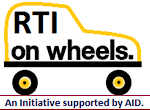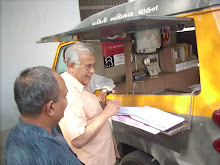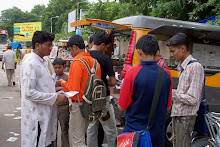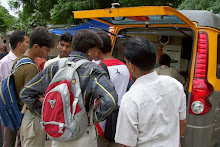India Legal: New Delhi: Thursday, August 03, 2017.
Shyamlal
Yadav has done path-breaking stories for India Today and The Indian Express by
leveraging RTI to the optimum. In his book, Journalism through RTI, he
describes how journalists should persist in digging out information. Extracts:
1.
Conceptualize the idea: More than the techniques of using RTI, what is
important is to first conceptualize the idea. It is important to ensure, as far
as possible, that one does not use RTI for information which is already
available in the public domain. This can be achieved only if one is well
informed and up to date. First, carefully go through all available means of information
to get ideas. Information may be accessed through annual reports, budget
speeches, government documents and publications, websites of various,
departments, Parliament and assembly questions, and interactions with sources
in the relevant departments. Very often, RTI users file applications for
information pertaining to minor, irrelevant topics. So before starting any RTI
exercise, get an idea of its possible impact based on a broader public
interest.
2. Begin by
getting available information without RTI: Once the idea is conceptualized, it
is important to first explore whether the information can be obtained without
using RTI. The best thing about using the Internet is that we can explore all
accessible information available in the public domain. Once one has accessed
all available information, only then one should draft the RTI application to
get information which is not available in the public domain. Before filing an
RTI application, reading the RTI Act is important to help one understand how to
proceed with an idea under RTI.
3. Don’t
question, just ask for information: The RTI Act gives us the right to
information and we can ask for any information which is available in any
format. Just concentrate on getting that information. Read the definition of
the information given in Section 2(f) of the RTI Act.
One may now
also use Prime Minister Narendra Modi’s comments on RTI which he made in the
annual RTI convention on October 16, 2015 at Vigyan Bhawan in Delhi. He said,
“Citizens should not only have the right to get copies of documents but also
ask question and demand accountability from public authorities, because the
right to ask questions is the very foundation of democracy and it will
reinforce their faith in democracy.”
4. Be simple
and clear in format and be aware of the loopholes: While drafting the
application asking for information, keep the format simple and easy to
comprehend. It is always better that a journalist seeking information does not
disclose the idea and just asks for that part of information he/she wants from
the concerned public authority. In some states and departments, they have
designed their own formats and they reject the queries if it is not filed in
their format, therefore, before filing the request, one must check with the
particular departments whether it has any format. Also, be aware that the
officer to whom the queries are addressed has a load of excuses to pass the
buck.
Once one has
accessed all available information, only then one should draft the RTI
application to get information which is not available in the public domain.
5. Know the
exemptions before you exercise the right: We must carefully go through and
understand Section 8(1) of the RTI Act before exercising our right to
information.
6. Try all
concerned public authorities for same information: If the same information is
available with multiple authorities, more than one authority can be approached.
It often happens that one authority denies the information, while another
provides the same without any ifs and buts. For example, in 2009, when I
requested the MHA to provide copies of its correspondence with the Delhi Government
on the Afzal Guru case, copies were not provided. But Delhi Government’s PIO
(public information officer) was quite helpful as he sent me the information
after I’d paid the cost of photocopying charges, etc.
7. Get
familiar with PIOs: We must try to meet and discuss things with the relevant
PIOs before sending an RTI application. There are several PIOs in the
government who are ready to share the information. Normally, the PIOs belong to
junior cadres like the Central Secretariat Services (CSS) and have a tendency
of being at odds with their senior officers like those from the IAS. Since
crucial decision-making in government starts at the joint secretary level, the
PIOs of junior rank such as section officers, under secretaries, and deputy
secretaries do not have much at stake if any embarrassing information is
released under the RTI.
The officers
themselves often give ideas for exciting stories once they are familiar with
the applicant and if they are sure that the information will be used in public
interest. We must utilize this conflict among government officials to explore
and collect crucial information.
8. Moving
targets: We should not give the impression to particular government departments
or public information officers that we use RTI only pertaining to them. We must
work with an approach of “Na kahoo se dosti, na kahoo se bair (No friendship
with anybody, no enmity with anybody).”
So, we should
always keep visiting new departments, governments (like state governments), and
ministries and be in constant touch with them for our ideas, because the truth
is that stories are everywhere.
9. No need to
reveal identity of a journalist: If we think some particular authority may not
respond favorably if it knows you are a journalist, avoid giving identity.
Sometimes, some public authorities, afraid that the information they are
providing will be published in the media and will create an impact, hesitate in
giving out information. Right to information is meant for every citizen of
India so we do not need to disclose who or what we are. Several public
authorities respond to queries without asking about the applicants, so it is up
to you whether you feel the need to disclose your identity or not and to file
your application giving your office address or home address.
The PIOs
themselves often give ideas for exciting stories once they are familiar with
the applicant and if they are sure that the information will be used in public
interest.
10. Be
prepared for any response: Some PIOs may initially confuse the applicant by
turning down the applications on one pretext or the other. They try to borrow
time and delay our information. Even when we file a request on behalf of our
news organization, the PIO may turn it down, as happened to me in the case of
IIT Kharagpur and IIM Ahmedabad. They turned down my applications saying that
the RTI Act “Confers the right to information on all ‘citizens’ and not on all
‘persons’. The ‘citizenship’ can only be a natural born person and it does not
even by implication include a legal or juristic person.” In such a situation,
take recourse to the CIC order dated September 17, 2007 which said that
“directors of companies, partners of firms, and office bearers of association
of persons could also seek information on behalf of the companies, firms and
associations respectively.”
11. Remember,
a NO doesn’t always mean NO: When officers dealing with RTI respond in a
negative way or do not provide the information, it does not necessarily mean
that they don’t want to provide the information. Sometimes, an informal,
personal meeting with them does the trick, while a first appeal against the
order creates extra pressure on them to provide the necessary information. We
should keep in mind that PIOs work under several seniors and the fact is that
they respond on behalf of their departments. Sometimes he/ she is personally
inclined to provide the information, but their seniors pressurize them not to.
Quite often, when we meet them personally, they will tell how to deal with the
hurdles and show the way to get the information. There are many instances in my
experience where the information was denied formally, but the same officers
provided the same information later, informally.
12. Don’t
waste time, file online or by post: In some states such as Maharashtra and
Odisha and with the Central Government, one can file an RTI online and submit
hard copies to any public authority or send it through postal services. One
does not need to go everywhere to submit the applications; the best way to save
time is to do so online or send them through post offices. It does not cost
much and saves valuable time. The easiest means of processing the fee is an
Indian postal order which can be bought from any post office. Also, in the name
of Central Government departments, the Postal Department has started issuing
e-postal orders which can be printed through India Posts’ website after making
an online payment.
13. Be
patient, be persistent: During the tedious and boring process of taking the RTI
route, one will often feel frustrated. But one must not lose patience because
the type of story one can get using RTI is usually not possible through other
means of investigative reporting. So, once the story is finalized, published,
and creates an impact, one will feel vindicated and elated. Sometimes such
stories will be among the award-winning entries. So, keep persisting with
efforts. I myself have filed many thousand applications, and a majority of them
were mere wastage of time, but I do not bother, for I have always concentrated
on the positive outcome of the efforts. Even without RTI, when a journalist
explores some story, often it needs much time and wasteful efforts, so what if
that happens under RTI as well? So, a journalist must be prepared always for
such efforts in search of a good story.
We should
always keep visiting new departments, state governments, and ministries and be
in constant touch with them for our ideas, because the truth is that stories
are everywhere.
14. Do extra
work on information: The information we access through RTI is hardly useful or
adequate for stories in the form in which it is supplied. It depends entirely
on us what information we finally manage to unearth after repeated efforts and,
more importantly, on how best we utilize them in formulating our idea and
writing the story. Very often, we will need to prepare multiple drafts to give
maturity to the idea and need to work several weeks or months to convert all
the accessed information into a hard-hitting story. Although several RTI
activists and NGOs supply and give access to information to journalists, only a
few of them have an impact, since it is not processed and analyzed in a proper
and effective journalistic manner.
15. Have
sensitivity toward RTI officials: While using RTI, journalists must always be
sensitive toward the person sitting across the table. One must be sensitive to
the fact that he/she is not given any extra remuneration for supplying
information and in case of any blunder he/she may have to face the
consequences. Also, we should remember that these officials are employed on
public money and they have to deal with RTI applications along with their other
official duties.
While the
government has enacted the RTI law, it does not fill the vacant posts in the
departments, so the officers are loaded with work. So, as far as possible, we
should avoid filing multiple requests in the same department for the same
information. And, we should not seek information which is already available in
the public domain. I realize through my experience that most of the officials
who deal with RTI provide the information without any hassle if they are
convinced that the applicant has only the public interest in mind. Therefore,
we should try to win their trust and make them realize that we are just doing
our job with the purpose of bringing about reforms in the system, nothing else.
16. Take help
from information commissioners: Since most of the information commissioners are
retired bureaucrats, they understand the functioning of the government system
and they know well what information is kept with which department. Although
some commissioners may be protecting particular persons, they largely would
like to be seen as pro-transparency and supportive of openness. We should take
benefit of their experience and utilize it to get ideas and in understanding
how, when, and where to move RTI.
As far as I
am concerned, I avoid taking my cases into CIC because it takes much time. What
I prefer is to meet the officials and file again another RTI with changed words
in the hope of access to information. But this must not be a principal for all
users. One must take its appeals to CIC/ SICs if information is denied by
PIO/FAA.
17.
Inspection of documents: As per section 2(j) of the RTI Act: Right to
information includes the right to: inspection of work, documents, records;
taking notes, extracts or certified copies of documents or records; taking
certified samples of material; obtaining information in the form of diskettes,
floppies, tapes, video cassettes or in any other electronic mode or through
printouts where such information is stored in a computer or in any other
device.
One must be
sensitive to the fact that an officer is not given any extra remuneration for
supplying information and in case of any blunder he/she may have to face the
consequences.
This
provision of inspection of documents must be utilized by journalists as, with
its help, one can easily penetrate any government office in order to develop
contacts for further stories besides getting the particular information on
hand.
18. Stories
from the ground: Real stories of grassroots-level development are with the
district administrations, several other government agencies at the district
level, panchayats, and offices at the ground level. So far, many stories have
not come, though there have been several efforts by some vernacular media; but
in the absence of proper ideation and training, all the process seems to be
held up now.
Media at the
grassroots level, like in most cases at the Center and states as well, depends
on the information accessed by NGOs and activists. For proper ideation and
effective use of RTI in public interest, vernacular and regional media persons
working at the grassroots level must be trained for that. Media men working
outside Delhi should take interest in that regard. Getting information from the
Central Government is easy, but it is very difficult to get correct and timely
information from… grassroots level offices of government.
19.
State-level stories: The same situation is at the state level. While many big
success stories have come from the Central Government on broad public interest
issues, in the states the case is not like that. Although some journalists in
the states have been using RTI, the need is to appoint a reporter in news
organizations as a full-time user of RTI who coordinates with other colleagues
on possible RTI-based stories and facilitates exploring those ideas.
In the
absence of proactive use of RTI by media in public interest, the RTI is losing
its shine in many states, and in some states such as UP, Chhattisgarh, Bihar,
and Odisha it depends on the luck of a user whether the request is responded to
and the information would be supplied or not and also the number of months the
response may take. Some state governments have become more and more resistant
toward RTI year after year, and one thing they never bother about is the time
limit of replying to an RTI request.
20. Follow
up, follow up: It is the beauty of the RTI Act that one can keep the public
authorities always on watch on any issue. Once the story is filed, we must not
forget the issue. What I do in many cases is file an RTI application just after
publishing the story to know the impact of the story. It makes our work
impact-making and significant. So, after publishing any story which is of
public interest, one may file an RTI application to know the follow-up.
Once a story
is published, one may not do the follow-up story, but RTI itself makes an
impact if we ask for the information regarding what was done by the concerned authorities
after the publication of the story.















































































